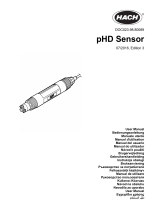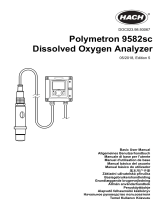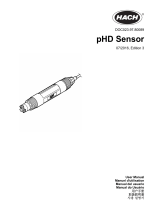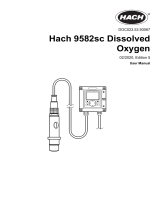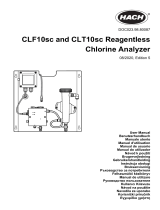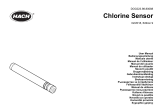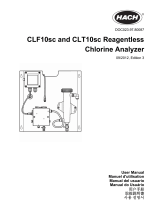Page is loading ...

Model FCLi
Free Chlorine Measuring System
Instruction Manual
PN 51-FCLi/rev.C
March 2012

ESSENTIAL INSTRUCTIONS
READ THIS PAGE BEFORE PROCEEDING!
Your purchase from Rosemount Analytical, Inc. has
resulted in one of the finest instruments available for
your particular application. These instruments have
been designed, and tested to meet many national and
international standards. Experience indicates that its
performance is directly related to the quality of the
installation and knowledge of the user in operating
and maintaining the instrument. To ensure their contin-
ued operation to the design specifications, personnel
should read this manual thoroughly before proceeding
with installation, commissioning, operation, and main-
tenance of this instrument. If this equipment is used in
a manner not specified by the manufacturer, the pro-
tection provided by it against hazards may be
impaired.
• Failure to follow the proper instructions may cause
any one of the following situations to occur: Loss of
life; personal injury; property damage; damage to this
instrument; and warranty invalidation.
• Ensure that you have received the correct model and
options from your purchase order. Verify that this
manual covers your model and options. If not, call 1-
800-854-8257 or 949-757-8500 to request correct
manual.
• For clarification of instructions, contact your
Rosemount representative.
• Follow all warnings, cautions, and instructions marked
on and supplied with the product.
• Use only qualified personnel to install, operate,
update, program and maintain the product.
• Educate your personnel in the proper installation,
operation, and maintenance of the product.
• Install equipment as specified in the Installation
section of this manual. Follow appropriate local and
national codes. Only connect the product to electrical
and pressure sources specified in this manual.
• Use only factory documented components for repair.
Tampering or unauthorized substitution of parts and
procedures can affect the performance and cause
unsafe operation of your process.
• All equipment doors must be closed and protective
covers must be in place unless qualified personnel
are performing maintenance.
• If this equipment is used in a manner not specified by
the manufacturer, the protection provided by it against
hazards may be impaired.
WARNINGS
RISK OF ELECTRICAL SHOCK
Equipment protected throughout by double insulation.
• Installation of cable connections and servicing of this product
require access to shock hazard voltage levels.
• Main power and relay contacts wired to separate power
source must be disconnected before servicing.
• Do not operate or energize instrument with case open!
• Signal wiring connected in this box must be rated at least 240 V.
• Non-metallic cable strain reliefs do not provide grounding
between conduit connections! Use grounding type bushings
and jumper wires.
• Unused cable conduit entries must be securely sealed by
non-flammable closures to provide enclosure integrity in com-
pliance with personal safety and environmental protection
requirements. Unused conduit openings must be sealed with
NEMA 4X or IP65 conduit plugs to maintain the ingress pro-
tection rating (NEMA 4X).
• Electrical installation must be in accordance with the National
Electrical Code (ANSI/NFPA-70) and/or any other applicable
national or local codes.
• Operate only with front and rear panels fastened and in place
over terminal area.
• Safety and performance require that this instrument be con-
nected and properly grounded through a three-wire power
source.
• Proper relay use and configuration is the responsibility of the
user.
CAUTION
This product generates, uses, and can radiate radio frequency
energy and thus can cause radio communication interference.
Improper installation, or operation, may increase such interfer-
ence. As temporarily permitted by regulation, this unit has not
been tested for compliance within the limits of Class A comput-
ing devices, pursuant to Subpart J of Part 15, of FCC Rules,
which are designed to provide reasonable protection against
such interference. Operation of this equipment in a residential
area may cause interference, in which case the user at his own
expense, will be required to take whatever measures may be
required to correct the interference.
WARNING
This product is not intended for use in the light industrial,
residential or commercial environments per the instru-
ment’s certification to EN50081-2.
Emerson Process Management
2400 Barranca Parkway
Irvine, CA 92606 USA
Tel: (949) 757-8500
Fax: (949) 474-7250
http://www.rosemountanalytica.com
© Rosemount Analytical Inc. 2012

QUICK START GUIDE
FOR FCLi ANALYZER
1. Refer to Section 2.0 for installation instructions, and Section 3.0 for wiring instructions.
2. Once connections are secured and verified, apply power to the analyzer.
3. When the analyzer is powered up for the first time, Quick Start screens appear. Using Quick Start is easy.
a. A blinking field shows the position of the cursor.
b. Use the t or u key to move the cursor left or right. Use the p or q key to move the cursor up or down or to
increase or decrease the value of a digit. Use the p or q key to move the decimal point.
c. Press ENTER to store a setting. Press EXIT to leave without storing changes. Pressing EXIT also returns the
display to the previous screen.
4. Choose the desired language. Choose >> to show more choices.
5. This screen appears if you have Model FCLi-02 (free chlorine and pH). Choose
two.
If you have Model FCLi-01 (free chlorine only), the screen does not appear.
6. Choose free for sensor 1.
7. Choose pH for sensor 2. If you have Model FCLi-01 (free chlorine only), this
screen does not appear.
8. Choose temperature units.
9. The main display appears. The outputs and alarms are assigned to default values.
10. Configure the analyzer for manual pH correction. Go to the main menu and
choose Program followed by Measurement. Choose Sensor 1 then Free
Chlorine. Choose Manual. In the next screen, enter pH 7,00. Do not choose
Auto.
11. To change outputs, alarms, and temperature-related settings, go to the main
menu and choose Program. Follow the prompts. For a guide to the Program
menu, see the menu tree on the following page.
12. To return the analyzer to the default settings, choose Reset Analyzer in the
Program menu.
# of sensors?
One
Two
Temperature in?
°C °
F
S1 Chlorine Type
free
total >>
S2 Measure?
pH
Redox ORP
English
Français
Español >>

QUICK REFERENCE GUIDE
MENU TREE FOR CHLORINE/pH MEASUREMENTS

i
MODEL FCLi TABLE OF CONTENTS
MODEL FCLi
SYSTEM FOR THE DETERMINATION OF FREE CHLORINE
TABLE OF CONTENTS
Section Title Page
1.0 DESCRIPTION AND SPECIFICATIONS ................................................................ 1
1.1 Features................................................................................................................... 1
1.2 Specifications........................................................................................................... 2
1.3 Ordering Information ................................................................................................ 3
2.0 INSTALLATION ....................................................................................................... 5
2.1 Unpacking and Inspection........................................................................................ 5
2.2 Installation................................................................................................................ 6
3.0 WIRING.................................................................................................................... 9
3.1 Power, Alarm, and Output Wiring............................................................................. 9
3.2 Sensor Wiring ......................................................................................................... 10
4.0 DISPLAY AND OPERATION ................................................................................... 11
4.1 Display ..................................................................................................................... 11
4.2 Keypad..................................................................................................................... 11
4.3 Programming and Calibrating the Analyzer - Tutorial .............................................. 12
4.4 Security .................................................................................................................... 13
4.5 Using Hold ............................................................................................................... 13
5.0 PROGRAMMING THE ANALYZER ........................................................................ 15
5.1 General .................................................................................................................... 15
5.2 Changing StartUp Settings....................................................................................... 15
5.3 Configuring and Ranging the Outputs...................................................................... 18
5.4 Configuring Alarms and Assigning Setpoints ........................................................... 20
5.5 Selecting Type of Chlorine Measurement ................................................................ 23
5.6 Choosing Temperature Units and Manual/Automatic Temperature Compensation . 26
5.7 Setting a Security Code ........................................................................................... 27
5.8 Noise Rejection........................................................................................................ 28
5.9 Single Sensor or Dual Sensor Input......................................................................... 28
5.10 Resetting Factory Calibration and Factory Default Settings .................................... 29
5.11 Selecting a Default Screen, Language, and Screen Contrast ................................. 29

Section Title Page
6.0 CALIBRATION ........................................................................................................ 31
6.1 Introduction .............................................................................................................. 31
6.2 Calibrating Temperature........................................................................................... 32
6.3 Calibration - Free Chlorine....................................................................................... 34
6.4 Auto Calibration - pH................................................................................................ 39
6.5 Manual Calibration - pH ........................................................................................... 41
6.6 Standardization - pH ................................................................................................ 43
6.7 Entering a Known Slope - pH................................................................................... 44
7.0 MAINTENANCE ..................................................................................................... 45
7.1 Analyzer ................................................................................................................... 45
7.2 Chlorine Sensor ....................................................................................................... 47
7.3 pH Sensor ................................................................................................................ 49
7.4 Constant Head Sampler........................................................................................... 49
8.0 TROUBLESHOOTING ............................................................................................ 53
8.1 Overview .................................................................................................................. 53
8.2 Troubleshooting Using Fault Codes......................................................................... 53
8.3 Troubleshooting When No Error Message is Showing - Free Chlorine ................... 55
8.4 Troubleshooting When No Error Message is Showing - pH..................................... 58
8.5 Troubleshooting When No Error Message is Showing - General ............................ 61
8.6 Simulating Inputs - Chlorine..................................................................................... 61
8.7 Simulating Inputs - pH.............................................................................................. 62
8.8 Simulating Temperature ........................................................................................... 63
8.9 Measuring Reference Voltage.................................................................................. 64
9.0 RETURN OF MATERIAL ........................................................................................ 65
LIST OF TABLES
Number Title Page
5-1 Default Settings ........................................................................................................ 16
7-1 Replacement Parts for FCLi (1055-01-11-24-68 or 1055-01-11-24-32-68) .............. 46
7-2 Spare Parts............................................................................................................... 48
7-3 Replacement Parts for Constant Head Flow Controller Assembly (Model FCLi-01) 50
7-4 Replacement Parts for Constant Head Flow Controller Assembly (Model FCLi-02) 51
MODEL FCLi TABLE OF CONTENTS
TABLE OF CONTENTS CONT’D
ii

MODEL FCLi TABLE OF CONTENTS
LIST OF FIGURES
Number Title Page
2-1 Chlorine Sensor Parts .............................................................................................. 7
2-2 FCLi-01 .................................................................................................................... 8
2-3 FCLi-2 ...................................................................................................................... 8
3-1 Wiring Connections .................................................................................................. 9
3-2 Wiring Diagram for Chlorine Sensor......................................................................... 10
3-3 Wiring Diagram for Chlorine pH Sensor Combination.............................................. 10
4-1 Displays During Normal Operation........................................................................... 11
4-2 FCLi Keypad ............................................................................................................ 11
5-1 Assigning Outputs 1 and 2 ...................................................................................... 18
5-2 High Alarm Logic ..................................................................................................... 20
5-3 Low Alarm Logic ....................................................................................................... 20
6-1 Sensor Current as a Function of Free Chlorine Concentration ................................ 34
6-2 Dual Slope Calibration.............................................................................................. 37
6-3 Calibration Slope and Offset .................................................................................... 39
7-1 Exploded View of Model FCLi Analyzer ................................................................... 46
7-2 Chlorine Sensor Parts .............................................................................................. 48
7-3 Replacement Parts for the Flow Controller Assembly used in Model FCLi-01......... 50
7-4 Replacement Parts for the Flow Controller Assembly used in Model FCLi-02......... 51
8-1 Pin Out Diagram for Model 499A CL-01-VP Sensor ................................................ 54
8-2 Pin Out Diagram for Model 399VP-09 Sensor ......................................................... 54
8-3 Simulating pH Inputs ................................................................................................ 62
8-4 Three-Wire RTD Configuration................................................................................. 63
8-5 Simulating RTD Inputs.............................................................................................. 63
8-6 Checking for a Poisoned Reference Electrode ........................................................ 64
iii

About This Document
This manual contains instructions for installation and operation of the Model FCLi Free
Chlorine Measuring System.
The following list provides notes concerning all revisions of this document.
Rev. Level
Date Notes
A 5/06 This is the initial release of the product manual. The manual
has been reformatted to reflect the Emerson documentation
style and updated to reflect any changes in the product offering.
B 3/07 Corrected typographical and format errors.
C 03/12 Update addresses - mail and web, and DNV certificate logo
Emerson Process Management
Liquid Division
2400 Barranca Parkway
Irvine, CA 92606 USA
Tel: (949) 757-8500
Fax: (949) 474-7250
http://www.raihome.com
© Rosemount Analytical Inc. 2007
MODEL FCLi ABOUT THIS DOCUMENT

MODEL FCLi SECTION 1.0
DESCRIPTION AND SPECIFICATIONS
SECTION 1.0.
DESCRIPTION AND SPECIFICATIONS
1.1 APPLICATIONS AND FEATURES
1.2 SPECIFICATIONS
1.3 ORDERING INFORMATION AND ACCESSORIES
1
• COMPLETE SYSTEM INCLUDES sensor, connecting cable, analyzer, and flow controller
• SENSOR RESPONSE IS PRACTICALLY INDEPENDENT of pH between pH 6 and 10
• NO REAGENTS
• NO AUXILIARY pH ELECTRODE
• VARIOPOL QUICK-DISCONNECT FITTINGS makes sensor replacement easy
1.1 APPLICATIONS AND FEATURES
The FCLi free chlorine system is intended for the determina-
tion of free chlorine (hypochlorous acid plus hypochlorite
ion) in fresh water. Unlike free chlorine analyzers from other
manufacturers, the FCLi does not use expensive sample
conditioning systems or messy reagents to control pH. Nor,
does it require an auxiliary pH sensor for pH correction.
Instead, the pH adjustment takes place inside the sensor,
producing a signal that changes less than 4% per unit
change in pH between pH 6 and 10. Below pH 6.5 the
change is less than 1%. The linear range of the sensor is 0
to 20 ppm (mg/L).
The FCLi is not intended for the determination of total or
combined chlorine (like monochloramine). Nor, can the FCLi
be used for the determination of chlorine in seawater.
The FCLi uses a three electrode, membrane-covered
amperometric sensor. The sensor consists of a hydrophilic
membrane stretched over a gold mesh cathode. A silver/sil-
ver chloride reference electrode and an external copper
auxiliary electrode complete the circuit. The fill solution is
saturated succinic acid slurry. During operation, an electro-
chemical reaction, driven by the polarizing voltage, con-
sumes free chlorine at the cathode surface. The auxiliary
electrode provides the electrons for the cathode reaction,
and a current proportional to the reaction rate flows between
the electrodes. Because the concentration of chlorine at the
cathode is zero, free chlorine in the sample continuously dif-
fuses through the membrane and is destroyed at the cath-
ode. Thus, the cathode current is proportional to the
diffusion rate, which is proportional to the concentration of
free chlorine in the sample.
Unlike other free chlorine sensors, the FCLi sensor requires
neither sample pretreatment nor pH correction. All ampero-
metric free chlorine sensors generate a raw current that
depends primarily on the concentration of hypochlorous
acid. Because the fraction of free chlorine present as
hypochlorous acid is a function of pH, readings will be in
error if the sample pH changes from the value it had during
calibration. To correct for pH changes, some manufacturers
treat the sample with acid to convert hypochlorite to
hypochlorous acid. Others continuously measure the pH and
use the pH value to correct the chlorine sensor reading. The
FCLi is different. The sensor uses a highly buffered acidic fill
solution for internal pH adjustment. The fill solution converts
all the free chlorine entering the sensor as well as much of
the free chlorine at the outside surface of the membrane into
hypochlorous acid. Thus, the sensor response is practically
independent of pH.
For customers who wish to measure pH, an option that
includes a pH sensor and flow cell is available.
Maintenance is fast and easy. Replacing a membrane
requires no special tools or fixtures. A screw cap holds the
pre-tensioned membrane in place. Replacing the membrane
and fill slurry takes only a few minutes.
The FCLi includes the easy-to-use Model 1055 analyzer.
The analyzer features two fully programmable 4-20 mA ana-
log outputs and three fully programmable alarm relays.
Programming and calibration is simple and intuitive. The
backlit, two-line display allows the user to read chlorine (and
pH) at a single glance.
Valves, rotameters, and pressure regulators to control sam-
ple flow are things of the past with the the Model FCLi. A
constant head overflow sampler ensures the correct flow to
the sensor no matter how much the sample flow or pressure
changes. To eliminate wiring hassles, quick disconnect
Variopol cable is standard.
Stable free chlorine standards do not exist. The chlorine sen-
sor must be calibrated using the results of a laboratory test
on a grab sample.

MODEL FCLi SECTION 1.0
DESCRIPTION AND SPECIFICATIONS
2
1.2 SPECIFICATIONS — GENERAL
Sample requirements:
Pressure: 3 to 65 psig (122 to 549 kPa abs)
A check valve in the inlet opens at 3 psig (122
kPa abs). If the check valve is removed, mini-
mum pressure is 1 psig (108 kpa abs).
Temperature: 32 to 122°F (0 to 50°)
Minimum Flow: 2 gal/hr (7.6 L/hr)
Maximum flow: 80 gal/hr (303 L/hr); high flow
causes the overflow tube to back up.
Sample Conductivity: >10 µS/cm
Process connection: 1/4-in OD tubing compression
fitting (can be removed and replaced with barbed
fitting for soft tubing).
Drain connection: 3/4-in barbed fitting. Sample must
drain to open atmosphere.
Wetted parts:
Overflow sampler: acrylic, polycarbonate,
polyester, Kynar
1
, nylon, silicone
Chlorine sensor: PVC, Viton
2
, silicone, polyether-
sulfone, polyester, and copper
pH sensor: Tefzel
2
, Viton, glass, ceramic
Response time to step change in chlorine concen-
tration: <120 sec to 90% of final reading for inlet
sample flow of 2 gph (7.6 L/hr).
Weight/shipping weight:
Model FCLi-01: 10 lb/13 lb (4.5 kg/6.0 kg)
Model FCLi-02: 11 lb/14 lb (5.0 kg/6.5 kg)
[rounded to the nearest 1 lb. (0.5 kg)]
SPECIFICATIONS — SENSOR
Free chlorine range: 0 to 20 ppm as Cl
2
. For higher
ranges, consult the factory.
Accuracy: Accuracy depends on the accuracy of the
chemical test used to calibrate the sensor
Linearity (0-20 ppm): 1% per IEC 60746
Linearity (0-2 ppm): ±0.05 ppm following calibration
at 2 ppm
Sensitivity to pH: Between pH 6.5 and 10, sensor
signal changes <4% per unit change in pH. Below
pH 6.5 the change is
<1% per unit change in pH.
Interferences: Monochloramine, dichloramine, and
permanganate
Electrolyte life: 3 months (approx.)
SPECIFICATIONS — ANALYZER
Case: Polycarbonate, NEMA 4X/CSA4 (IP65)
Display: Two-line, 16-character, back-lit. Character
height: 4.8 mm.
Languages: English, German, Italian, Spanish,
French, Portuguese
Ambient temperature and humidity: 0 to 50°C (32
to 122°F); RH 5 to 95% (con-condensing)
The analyzer can be operated between -20 and
60°C (-4 to 140°F) with some degradation in dis-
play performance.
Power: 115/230Vac ± 15%, 50/60 Hz ± 6%, 8.0 W.
Installation category II.
Equipment protected
throughout by double
insulation.
RFI/EMI: EN-61326
LVD: EN-61010-1
Outputs: Two 4-20 mA or 0-20 mA isolated outputs.
Continuously adjustable. Linear or logarithmic.
Maximum load 500 ohms. Output dampening
with time constant of 5 sec is user-selectable.
Alarms: Three alarm relays for process meas-
ure- ment(s) or temperature. Alarm 3 can be
configured as a fault alarm, instead of a
process alarm. Each relay can be configured
independently. Alarm logic (high or low activation)
and deadband are user-programmable.
Relays: Form C, single pole double throw, epoxy sealed
1
Kynar is a registered trademark of Elf Atochem North America.
2
Viton and Tefzel are registered trademarks of DuPont
Performance Eastomers.
Resistive Inductive
28 Vdc 5.0 A 3.0 A
115 Vac 5.0 A 3.0 A
Ordinary Location:
POLLUTION DEGREE 2: Normally only non-con-
ductive pollution occurs. Occasionally, however, a
temporary conductivity caused by condensation
must be expected.
12RN

MODEL FCLi SECTION 1.0
DESCRIPTION AND SPECIFICATIONS
3
1.3 ORDERING INFORMATION
Model FCLi Free Chlorine Measuring System. The FCLi is a complete system for the determination of free
chlorine in aqueous samples. It consists of the sensor(s), analyzer, and constant head flow controller. All compo-
nents are mounted on a backplate. Model option -02 includes a pH sensor for customers who wish to measure
pH in addition to free chlorine. Three replacement membranes and enough electrolyte chemicals to fill the sensor
three times are shipped with each sensor.
ACCESSORIES
PART # DESCRIPTION
9240048-00 Tag, stainless steel (specify marking)
COMPONENT PARTS
ANALYZER MODEL DESCRIPTION
1055-01-11-24-68 1055 analyzer, single input (chlorine), wall mount, 115/230 Vac
1055-01-11-24-32-68 1055 analyzer, dual input (chlorine and pH), wall mount, 115/230 Vac
SENSOR MODEL DESCRIPTION
498CL-01-VP pH-independent free chlorine sensor with Variopol connector
399VP-09 pH sensor with Variopol connector
SENSOR CABLE DESCRIPTION
24150-00 Interconnecting cable, Variopol for 498ACL sensor, 4 ft
23645-08 Interconnecting cable, Variopol for 399VP sensor, 4 ft
CODE pH CORRECTION (required selection)
01 Without pH sensor
02 With pH sensor
MODEL FCLi FREE CHLORINE MEASURING SYSTEM
FCL
i
-02 EXAMPLE
SPARE PARTS
PART # DESCRIPTION
33970-00 Fill plug
33968-00 Membrane retainer
9550094 O-ring, 2-014, Viton
®
23501-10 pH-independent free chlorine membrane assembly, includes one membrane assembly and O-ring
23502-10 pH-independent free chlorine membrane assembly, includes three membrane assemblies and three
O-rings
24146-00 pH-independent free chlorine sensor electrolyte kit, includes three bottles of saturated succinic acid and
three bottles of succinic acid crystals

4
This page intentionally left blank.

5
SECTION 2.0.
INSTALLATION
MODEL FCLi SECTION 2.0
INSTALLATION
2.1 UNPACKING AND INSPECTION
2.2 INSTALLATION
2.1 UNPACKING AND INSPECTION
Inspect the shipping container. If it is damaged, contact the shipper immediately for instructions. Save the box. If
there is no apparent damage, unpack the container. Be sure all items shown on the packing list are present. If
items are missing, notify Rosemount Analytical immediately.
2.1.1 FCLi-01 (free chlorine without pH sensor)
The FCLi-01 consists of the following items mounted on a back plate.
1. Model 1055-01-11-24 analyzer with sensor cable attached.
2. Constant head overflow sampler with flow cell for chlorine sensor.
The free chlorine sensor (Model 498CL-01-VP), three membrane assemblies, and enough electrolyte chemicals
to fill the sensor three times are in a separate package.
2.1.2 FCLi-02 (free chlorine with pH sensor)
The FCLi-02 consists of the following items mounted on a back plate.
1. The 1055-01-11-24-32 analyzer with sensor cables attached.
2. Constant head overflow sampler with flow cells for pH and chlorine sensors.
3. Stand to hold pH buffer solution during calibration.
The free chlorine sensor (498CL-01-VP), shipped with three membrane assemblies and enough electrolyte chem-
icals to fill the sensor three times, and the Model 399VP-09 pH sensor are in separate packages.

6
MODEL FCLi SECTION 2.0
INSTALLATION
2.2 INSTALLATION
2.2.1 General Information
1. Although the system is suitable for outdoor use, do not install it in direct sunlight or in areas of extreme
temperature.
2. To keep the analyzer enclosure watertight, install plugs (provided) in the unused cable openings.
3. Install the system in an area where vibrations and electromagnetic and radio frequency interference are
minimized or absent.
4. Be sure there is easy access to the analyzer and sensors.
2.2.2 Sample Requirements
Be sure the sample meets the following requirements:
1. Temperature: 32 to 122ºF (0 to 50ºC)
2. Pressure: 3 to 65 psig (122 to 549 kPa abs)
3. Minimum flow: 2 gal/hr (7.6 L/hr)
2.2.3 Mounting and Making Inlet and Drain Connections
The Model FCLi is intended for wall mounting only. Refer to Figure 2-2 or 2-3 for details.
A 1/4-inch OD tubing compression fitting is provided for the sample inlet. If desired, the compression fitting can
be removed and replaced with a barbed fitting. The fitting screws into a 1/4-inch FNPT check valve. The check
valve prevents the sensor flow cells from going dry if sample flow is lost.
The sample drains through a 3/4-inch barbed fitting. Attach a piece of soft tubing to the fitting and allow the waste
to drain open atmosphere. Do not restrict the drain line.
Remove the foam packing insert between the outer tube and the inner overflow tube. Adjust the sample flow
until the water level is even with the central overflow tube and excess water is flowing down the tube.
2.2.4 Electrical Connections
Refer to Section 3.1 for details.
2.2.5 Installing the Sensor(s)
1. The chlorine sensor leaves the factory with a shipping membrane in place. The shipping membrane
must be removed before putting the sensor in service. Do not remove the shipping membrane until
you are ready to put the sensor in service.
a. Remove the red protective cap from the end of the sensor.
b. Holding the membrane end pointing up (cable end pointing down), unscrew the retainer cap and remove
the shipping membrane. See Figure 2.1. It is not necessary to remove the O-ring. Save the shipping
membrane. It should be reinstalled on the sensor when the sensor is not in use.
c. Still holding the membrane end pointing up, install the chlorine membrane. The chlorine membrane is in
the plastic bag attached to the sensor. Screw the retainer back in place.

MODEL FCLi SECTION 2.0
INSTALLATION
2. Remove the protective cap on the pH sensor.
3. Install the sensors in the flow cells as shown in Figures 2.2 and 2.3. For Model FCLi-02, the pH sensor must
be installed as shown in Figure 2.3. The chlorine sensor sits in the flow cell and is held in place by the union
nut. The pH sensor screws into a plastic fitting, which the union nut holds in the flow cell. Be sure to slip the
union nut over each sensor before connecting the cable to the sensor.
4. The Model FCLi is provided with sensor cables pre-wired to the analyzer. Connect the chlorine sensor to the
cable labeled Chlorine Sensor. Connect the pH sensor to the cable labeled pH Sensor. The terminal end of
the sensor is keyed to ensure proper mating with the cable receptacle. Once the key has slid into the mating
slot, tighten the connection by turning the knurled ring clockwise. As soon as the chlorine sensor has been
connected to the cable, place the sensor in a flowing sample. Do not let the sensor stand in non-
flowing water for longer than about 45 minutes.
5. Do not place the chlorine sensor in the flow cell unless the sample is flowing. Do not let the chlorine sensor
stand in non-flowing water for longer than about 45 minutes. Do not leave the chlorine sensor in air. The
membrane will dry out.
FIGURE 2-1. Chlorine Sensor Parts
fill plug
o-ring
membrane
assembly
membrane
retainer cap
cable
end
7

8
MODEL FCLi SECTION 2.0
INSTALLATION
FIGURE 2-2. Model FCLi-01
FIGURE 2-3. Model FCLi-02
chlorine sensor
pH sensor
chlorine sensor

SECTION 3.0.
WIRING
3.1 POWER, ALARM, AND OUTPUT WIRING
3.2 SENSOR WIRING
MODEL FCLi SECTION 3.0
WIRING
3.1 POWER, ALARM, AND OUTPUT WIRING
See Figure 3-1 for identification of power, alarm, and output terminals. Note that the sensor cables are already
wired to the analyzer.
AC power wiring should be 14 gauge or greater. Run the power wiring through the conduit opening nearest the
power terminal (TB1). Provide a switch or breaker to disconnect the analyzer from the main power supply. Install
the switch or breaker near the analyzer and label it as the disconnecting device for the analyzer.
Keep output signal wiring separate from power wiring. Do run signal and power wiring in the same conduit or close
together in a cable tray.
For best EMI/RFI protection use shielded output signal cable enclosed in an earth-grounded metal conduit.
Connect the shield to earth ground at TB1-4.
Keep output wiring at least one foot from high voltage conductors.
To reduce stress on the wiring connections, do not remove the hinged front panel from the base while installing
wiring. Be sure there is sufficient cable slack in the enclosure to avoid stress on the conductors and connections.
Do not allow wiring to press on the transformer and power supply board.
AC connections and grounding must be
in compliance with UL 508 or local elec-
trical code. DO NOT apply power to the
analyzer until all electrical connections
are verified and secure.
WARNING:
RISK OF ELECTRICAL SHOCK
Figure 3-1. Wiring connections.
9

10
MODEL FCLi SECTION 3.0
WIRING
3.2 SENSOR WIRING
The Model FCLi is provided with sensor cables pre-wired to the analyzer.
If it is necessary to replace the cable, refer to the wiring diagrams below. Figure 3-2 is the sensor wiring diagram
for Model FCLi-01 (free chlorine sensor only). Figure 3-3 is the sensor wiring diagram for Model FCLi-02 (free chlo-
rine and pH sensor). The jumper (PN 23988-00) between TB5-4 (solution ground) and TB5-6 (pH reference) in
Figure 3-3 is an integral part of the circuit. It must be installed as shown.
Figure 3-2. Wiring diagram for chlorine sensor.
Figure 3-3. Wiring diagram for chlorine pH sensor combination.

MODEL FCLi SECTION 4.0
DISPLAY AND OPERATION
SECTION 4.0
DISPLAY AND OPERATION
4.1 DISPLAY
4.2 KEYPAD
4.3 PROGRAMMING AND CALIBRATING THE ANALYZER - TUTORIAL
4.4 SECURITY
4.5 USING HOLD
4.1. DISPLAY
The Model FCLi analyzer has a two-line
display. The display can be customized
to meet user requirements (see Section
5.11). Figure 4-1 shows some of the dis-
plays. View A is the default screen for
Model FCLi-02 (chlorine and pH sen-
sor). View C is the default screen for
Model FCLi-01 (chlorine sensor only).
The FCLi analyzer has information
screens that supplement the data in the
main display. Press p or q to view the
information screens. The last informa-
tion screen is the software version.
During calibration and programming,
key presses cause different displays to
appear. The displays are self-explanato-
ry and guide the user step-by-step
through the procedure.
4.2 KEYPAD
Figure 4-2 shows the keypad.
FIGURE 4-1. Displays During Normal Operation
Screen A shows chlorine and pH. The temperature shown is the tempera-
ture measured by the chlorine sensor. Screen B shows chlorine and pH
and the temperature measured by each sensor. Screen C shows the data
for the chlorine sensor only.
FIGURE 4-2. FCLi Analyzer Keypad
Four arrow keys move the cursor around the screen. A blinking word or
numeral show the position of the cursor. The arrow keys are also used to
change the value of a numeral. Pressing ENTER stores numbers and set-
tings and moves the display to the next screen. Pressing EXIT returns to
the previous screen without storing changes. Pressing MENU always
causes the main menu screen to appear. Pressing MENU followed by
EXIT causes the main display to appear.
11

12
MODEL FCLi SECTION 4.0
DISPLAY AND OPERATION
4.3 PROGRAMMING AND CALIBRATING THE ANALYZER -
TUTORIAL
Setting up and calibrating the FCLi is easy. The following tutorial describes
how to move around in the programming menus. For practice, the tutorial also
describes how to assign chlorine values to the 4 and 20 mA outputs for sen-
sor 1 (free chlorine sensor).
1. If the MENU screen (shown at the left) is not already showing, press
MENU. Calibrate is blinking, which means the cursor is on Calibrate.
2. To assign values to current outputs, the Program sub-menu must be open.
Press q. The cursor moves to Program (Program blinking). Press ENTER.
Pressing ENTER opens the Program sub-menu.
3. The Program sub-menu permits the user to set outputs, alarms, auto-
matic or manual temperature compensation, and a security code. When
the sub-menu opens, Outputs is blinking, which means the cursor is on
Outputs. Press q or u (or any arrow key) to move the cursor around the
display. Move the cursor to >> and press ENTER to cause a second
screen with more program items to appear. There are three screens in the
Program menu. Pressing >> and ENTER in the third screen causes the
display to return to the first screen (Outputs, Alarms, Measurement).
4. For practice, assign values to the 4 and 20 mA outputs for sensor 1. Move
the cursor to Outputs and press ENTER.
5. The screen shown at left appears. The cursor is on Output Range (blink-
ing). Output range is used to assign values to the low and high current
outputs. Press ENTER.
6. The screen shown at left appears. The FCLi has two outputs, output 1
and output 2. Move the cursor to the desired output and press ENTER.
For purposes of the example, choose Output 1.
7. The screen shown at left appears. Out1 S1 in the top line means output
1 (Out1) is assigned to sensor 1 (S1). Either output can be assigned to
either sensor (sensor and output assignments are made under the
Output Configure menu shown in step 5). Use the Out1 S1 Range?
screen to assign a chlorine concentration to the 4 mA output.
a. Use the arrow keys to change the concentration to the desired value.
Press t or u to move the cursor from digit to digit. Press p or q to
increase or decrease the value of the digit. Holding p or q down
causes the numeral to continuously scroll up or down.
b. To move the decimal point, press t or u until the cursor is on the
decimal point. Press p to move the decimal point to the right. Press
q
to move the decimal point to the left.
c. Press ENTER to store the setting.
8. The screen shown at left appears. Use this screen to assign a full scale
chlorine concentration to the 20 mA output. Use the arrow keys to change
the chlorine to the desired value. Press ENTER to store the setting.
9. The screen shown at left appears. To assign values to the low and high
currents for output 2, select Output 2 and follow the prompts.
10. To return to the main menu, press MENU. To return to the main display
press MENU then EXIT, or press EXIT repeatedly until the main display
appears. To return to the previous display press EXIT.
NOTE
To store values or settings, press ENTER before pressing EXIT.
Calibrate
Hold
Program Display
Calibrate Hold
Program
Display
Outputs
Alarms
Measurement >>
Output Range
Output Configure
Output Range?
Output1
Output2
Out1 S1 Range?
4mA
0
0.00ppm
Out1 S1 Range?
20mA
2
0.00ppm
Output Range?
Output1
Output2
/
